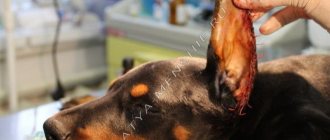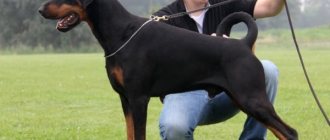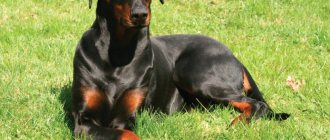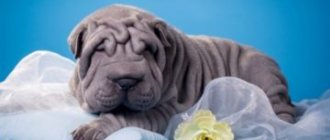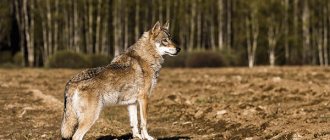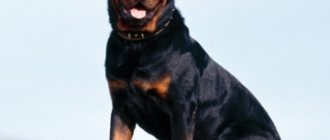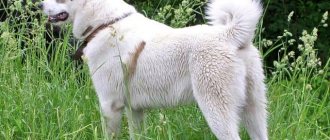You have decided to get a dog, and this is very correct. From the moment a puppy arrives in the house, life will become more interesting. There will not be a single family member left who will not be affected by the care of a small pet. Many new things and events will appear around you, from an unusual daily routine, pleasant and unpleasant responsibilities to new friends, and sometimes new enemies.
Your choice fell on the Doberman, which means that all of the above can be safely multiplied by two.
Doberman content
When deciding to get a purebred dog, you should definitely get acquainted with the history of its creation. Knowing the qualities inherent in it by the author of the breed will make life easier and more enjoyable side by side with a new friend.
In the mid-19th century, Karl Friedrich Louis Dobermann, a tax collector and night policeman from Thuringia, brought out a reliable security guard for himself. When creating the breed, he used a German pinscher, a Beauceron, a Rottweiler and a hunting pointer.
ADVICE! Read about each of these dogs to get a better idea of what qualities your future pet will have. In his homeland, he quickly became the first deputy of the police, the embodiment of law and order.
The Doberman is a strong, robust, beautiful, very cheerful dog that is easy to train. We have listed these qualities of a dog not to decorate the article, but so that you can once again weigh the pros and cons when choosing a puppy breed. The physical parameters of dogs can vary depending on gender, heredity and growing conditions. The lower limit of height at the withers is 63 centimeters, and the upper limit is 74. Weight is from 32 to 45 kilograms. Mentally imagine this “baby” in your apartment.
If there is little space, then difficulties are inevitable. Owners of country houses place dogs in enclosures. Such a decision regarding the Doberman must be approached very carefully, with common sense. Can this dog live outside in winter? Yes, if you live in a climate with warm winters, and there is a definite no to living an animal with virtually no undercoat outside during cold winters.
“Very cheerful” - immediately think realistically about who will walk the dog. Children and the older generation are not suitable for this role. It is not easy to hold a nine-month-old Doberman puppy, weighing more than thirty kilograms and having a height at the withers of 70 centimeters, if he decides to play with a dog or catch up with a cat. To the question whether weak people can cope with an adult, untrained dog, the answer is clear - NO!
“Easy to train” - in the modern world, the Doberman is more often a pet, a companion dog. But this in no way means that training can be neglected.
IMPORTANT! Remember what qualities are in the blood of a Doberman! The goal of the training is to get a reliable protector who will not be aggressive towards other people and animals.
Answer honestly for yourself the question of how and where you will train your Doberman. Do you have the patience for this time, a sparsely populated park near your home and money for the services of a trainer if you can’t handle it on your own?
This is where the word MONEY appeared in our article for the first time. Be prepared for the fact that with the arrival of the puppy it will sound in your house very often and considerable sums will be involved.
Initial costs
It is impossible to give a specific figure for expected expenses. Knowing the main cost items, you can add up the prices of goods and services in your city and imagine the cost of owning a dog.
You will have to consider:
- The cost of a puppy.
Buying a puppy always feels like a lottery. Even the best breed expert cannot guarantee that your little pet will turn into an impeccable dog with a magnificent exterior and an easy-going disposition. But still, buying a pet from a good kennel club, where you can get acquainted with the baby’s pedigree, and most importantly, see his parents, is much preferable than purchasing a dog of unknown inclinations that looks like a Doberman Pinscher.
The price of club puppies can be very affordable. If you do not plan to raise a show dog, then you can buy a pet with a small defect. This unpleasant word can simply mean a deviation in color or body proportions. Nevertheless, you will become the owner of a purebred individual with all the necessary documents. You can pay attention to the older club puppies. In such cases, try to understand the reasons for the delay from the breeder.
- Expenses for essentials:
- diapers;
- bed;
- bowls and a special stand for them;
- toys;
- collar, leash, harness, muzzle, overalls.
- Feed.
- Veterinarian services.
Mandatory expenses:
- vaccinations;
- deworming;
- issuance of veterinary passports and certificates.
Not mandatory, but inevitable:
- treatment (examinations, tests, procedures, medications, operations);
- docking of ears and tail;
- chipping;
- cutting your nails and cleaning your ears (until you get the hang of it).
- Training.
How does he get along with children?
One of the main questions when deciding whether to get a Doberman is how does it get along with children? The answer is great! After all, he himself, even as an adult, looks like a mischievous, cheerful teenager. The main condition for a trouble-free life with a dog in a house where there are children is EDUCATION! And what’s important is that this applies equally to animals and children.
History of the breed
This breed began in Germany, because it is no coincidence that it received the name Doberman - that was the name of the first breeder - Carlos Dobermann . While working as a tax collector, he ran a slaughterhouse, which gave him the right to catch stray animals. Among the “prey” he was interested in “butcher dogs” (a less well-known name in Germany for Rottweilers). At that time, these dogs were already able to form into an independent breed. It is not surprising that it was thanks to them that the Doberman breed was largely developed. Carlos Luis planned everything carefully, because he knew from the very beginning that he should succeed.
One of the primary goals that he set for himself was to create a breed that would perfectly cope with the role of a protector. But, unfortunately, it is impossible to confirm this fact, since records of Dobermann’s work have not survived. Scientists only have information that, while visiting one of the exhibitions, he acquired two puppies, from which a black and red female was subsequently born . Subsequently, they continued to conduct experiments with it, crossing other breeds, including the “butcher’s dog.”
Carlos had quite a choice, because he used herding dogs, a Thuringian Shepherd and a Wemorian hunting dog. The latter’s contribution to the final breed was that the Doberman acquired a bluish tint to the main color.
The Doberman breed, bred in this way, was known for a long time only to a small circle of people, but everything changed in 1898, when it was recognized at the official level. Unfortunately, this only happened after the death of its creator. The breed itself did not immediately acquire its official name. Before this significant event, it was known as the Thuringian Pinschers . When it was officially recognized, the dogs began to be called Doberman Pinschers. Dobermans, first of all, performed well in the army and police. This subsequently led to the emergence and spread of their unofficial name - gendarmerie dog.
How to properly raise a Doberman
Everything you do for your pet from the first minutes of his appearance in the house is upbringing. It is impossible to say that nutrition is more important than walking or that training can be abandoned in favor of games.
IMPORTANT! Remember that the ideal Doberman is a healthy animal with a stable nervous system that is CALM about everything that surrounds it.
The main task of the owner is to learn to understand his dog and know how to influence it.
Praise and reward for the right actions and punish for the wrong ones.
Remember that punishment always has its limits, and never cross them.
When raising a Doberman, you cannot start from a position of strength, put pressure and force your pet.
Only kindness and full contact with your four-legged friend.
If this is your first service dog, it is best to come to a training facility where they will teach you how to understand it.
Breed defects
The following defects in the dog’s appearance can be defects of the breed:
- the presence of soft and wavy hair;
- the appearance of light or darkened tan marks, white marks;
- the presence of thick and clearly visible undercoat;
- amble;
- the presence of proximity of the hock joints, incorrect angles of joints and dewclaws;
- the presence of twisted elbows, clubfoot or dislocation;
- lack of muscles;
- formation of a barrel-shaped, flat or narrow chest;
- the presence of bulging eyes, as well as a thick and short neck with a dewlap.
Among other things, shortcomings can be represented by a convex frontal part or bridge of the nose, a sharp transition or its complete absence, a heavy and short head, high cheekbones, a sharp muzzle, thick lips and low-set ears.
What does a growing Doberman need?
The puppy has grown up, been vaccinated, and it’s time to take him for walks outside. When choosing ammunition, take your dog with you to the store, where you can try it on and choose the best option.
Collar:
- wide enough so as not to put pressure on the dog’s neck;
- multi-layered so that it does not tear at the most inopportune moment;
- with a durable welded ring for attaching the leash.
Muzzle:
- Should allow the dog to open its mouth slightly to breathe. You need to make sure that her nose does not rest against the front wall, but does not slide down, keeping well on the muzzle.
- Good quality plastic muzzles are comfortable. They are durable, hygienic (can be washed after a walk) and do not conduct cold.
Leash:
- Take his choice seriously - sometimes the dog's life depends on it. Pay special attention to the carabiner. It should be made of good metal, not bend or break, fasten securely and fit the collar ring. Be sure to have a swivel that allows the carabiner to spin and gives the dog the opportunity to cut circles around the owner without tangling the leash.
Harness:
- Used for strength and towing training, in guard and search work. It allows you to evenly distribute the load on the chest and body when the dog pulls.
- Requirements: It must fit snugly on the dog, without dangling or constricting the body.
- The harness is not intended for permanent use because it shifts the center of gravity.
Aviary:
- Owners of their own estate can build an aviary with an insulated booth on the site. It will come in handy for the Doberman in the summer, in case the dog is unable to get into the house while the owner is away. Here she can wait out the rain or bad weather.
Appearance of the animal
The Doberman is a medium-sized dog with a powerful, muscular body, combining noble posture, graceful and clear lines.
The appearance of the animal is distinguished by elegant and clear lines.
The dog has the best anatomical structure. The entire exterior is visible, so it’s difficult to hide flaws. The combination of power, large reserves of internal energy, external grace and aristocratic sophistication gives a good impression of the Doberman.
Main settings
The height of a male at the withers reaches 72 cm, that of a female - 68 cm. Deviations upward or downward of more than 2 cm are considered a significant fault. An adult male Doberman weighs 40-45 kg, a female – 32-35 kg. The Doberman has average parameters and a harmonious build. There are no signs of rough outline or excessive massiveness of the body. The dog is more square than elongated. The height at the withers is approximately equal to the length of the body.
Head
This part of the body corresponds to the general dimensions. When viewed from above, the shape of the head resembles a blunt wedge. The top line from the front looks even and does not fall towards the ears. The transition between the forehead and nose is visible, but not very pronounced. The jaw muscles are well developed, the dog has no cheeks.
Muzzle
The length of this part practically coincides with the corresponding parameter of the skull. The opening of the mouth reaches the molars. The opening of the mouth is wide. The nose ends in a large, but not protruding, black lobe. Lighter shades are allowed if the animal has the appropriate color.
The jaw muscles on the muzzle are well developed.
Dry lips fit tightly to powerful, wide jaws. A scissors bite is considered correct.
Eyes and ears
The eye shape is oval, medium length. The iris is dark brown. Light Dobermans may have other eye colors. Dobermans have high-set ears. After docking, they stand upright. In some countries, such procedures are prohibited. Dobermans' undocked ears hang down, but do not fit too tightly to the head.
Frame
The dog has a straight, long neck with well-developed muscles. The back begins with prominent withers. The lumbar region is short. For bitches, slight elongation of this part of the body is allowed. The croup is rounded. The chest is wide and convex, with slightly prominent ribs. Its anterior part is well developed. The optimal depth of the chest is equal to half the height of the animal.
Tail
This part of the dog's body is set high. When docking, only 2 vertebrae are left. If such a procedure is prohibited, a natural tail is left.
The Doberman's tail is set high.
Paws
The stance of the forelimbs is straight and vertical. The muscles are well developed. The hind limbs are set parallel. Most of the muscles are concentrated in the thigh area. Both the front and hind legs are short, with arched toes that form a ball and end in dark, thick claws.
Wool
The Doberman's hair is short, smooth, and stiff. It fits tightly to the skin and is evenly distributed throughout the body. This breed has no undercoat.
Color
The standards recognize black or brown Dobermans. The presence of red spots with clear boundaries is mandatory.
Caring for a Doberman
Nail trimming:
- It is carried out at least once a month to avoid changes in gait and stress on the joints. It is important not to let the nails grow too long, so as not to injure the blood vessel that grows along with the nail.
- To prevent this procedure from turning into a test for the dog, teach your Doberman to cut his nails from childhood. Reward calm behavior with treats.
- The best tool is a durable nail clipper with a stopper.
Mouth hygiene:
- Clean teeth contribute to the dog's overall health. Tartar and plaque cause bad odor and cause tooth loss.
- Inspect the oral cavity every day, feed it properly, and sometimes let your Doberman chew on a special vein bone.
- If desired and possible, the owner can brush his pet’s teeth daily with special toothpastes .
Color
Initially, the breed standard, approved in 1899, recognized exclusively black color. In 1901, the Association of Dog Trainers included representatives of these brown dogs in its register.
In accordance with the established characteristics of the breed, there can be two types of Dobermans based on coat color:
- black;
- brown.
With the exception of Britain and the USA, only these two coat colors are recognized in all countries.
The color of both varieties of this breed has a remarkable feature - the presence of tan or red tan.
In both the black Doberman and its brown relative, you can see such tan marks in the eyelid area, on the cheekbones, and in the chest area between the forelimbs. Similarly, such markings are visible inside the ears, near the mouth and under the tail. There are also such tan marks on the limbs of the hind and front legs.
Black Dobermans
In frequently seen photos of a Doberman, you can usually see a dog of this breed with exactly this color. Such animals with their dark coat color make an indelible impression, emphasized by the contrast of color of almost the entire body and local lightened tan marks in certain areas.
This color is considered the main color for these dogs.
However, some puppies are born entirely of this color, with barely noticeable darkened tan marks. Such dogs are not allowed to participate in exhibitions. Likewise, they are not used for purebred breeding and production of puppies. But in service dog breeding, such pets bring benefits no less than their relatives with the appropriate coat color.
Melanism - a uniform color - is considered a defect; such cases are rare.
The advantage of dogs of this breed with this color is their bright red tan, which contrastsly emphasizes individual elements of the exterior. Darkening or too light a shade is considered an anomaly.
The classification of colors with this coat color suggests two options:
- anthracite - with shiny wool;
- deep dark - with a slight reddish tint, noticeable in the sun's rays.
Such features are dictated by the action of dominant genes. In the first case, this is the result of purebred genetics. In the second, it is a consequence of greater activity of genes that contain a red tint.
Brown Dobermans
Dog breeders consider the advantage of the brown color to be its visual appeal. Shades from red to dark chocolate give the dog softness, while significantly enlarging the body when visually assessed. Dogs' eyes are brown, with a slightly light tint. The color of the nose is light brown, uniform.
Brown Doberman
In addition to these colors, there are varieties of dogs with non-standard coat colors. These include albinos (usually white), who are not recognized by dog handlers in any country in the world. In addition, as a result of genetic disorders, even parents of the same color may produce offspring of isabella, blue, or red shades. All of these colors of Dobermans are considered abnormal, and such dogs are not allowed to breed with purebreds of a standard color or to participate in exhibitions.
Cupping
On this occasion, more than one spear has been broken in modern dog breeding.
If you are attracted to the image of a Doberman with cropped ears and tail, then it is worth remembering that this operation must be performed before the puppy is 12 weeks old. At a later date, it will be more difficult for his body to cope with the load of healing surgical sutures.
It is definitely better to entrust this work to a veterinarian. In a good clinic, the puppy will be given safe anesthesia, clamps will be placed on the ears to form the future shape of the ear, trimmed to fit the size of the head, and stitches will be placed correctly. A good surgeon acts as a sculptor in this operation.
Then you will have to go through the installation of the ears - attaching the operated ears to a special frame using an adhesive plaster.
Be sure to consult with the breeder about how to do this correctly so as not to spoil the surgeon’s work, and most importantly, the dog’s appearance.
In many European countries, starting with the homeland of these dogs - Germany, a legal ban on docking has been introduced. Dobermans with uncropped ears and tails are full-fledged representatives of their breed.
Training
Considering that Dobermans are somewhat capricious and love to dominate, they require strict education and training. Dogs of this breed are very smart and easily sense the weaknesses of their owner. To gain credibility, a breeder needs to be persistent, firm and consistent. Any weakness can undermine the owner’s leadership in the eyes of the pet. Intelligence and intelligence allow the Doberman to quickly achieve results and master new commands. By the way, any active activity in the company of the owner is the best pastime for the animal.
But, despite the love for work and study, the Doberman should be trained taking into account some features:
- If the dog is tired, training should be postponed for a while. Otherwise, you may encounter stubbornness.
- When your pet is bored with monotonous commands, it is worth reconsidering the systematic presentation of tasks.
- There is no need to use physical force or punish your pet. Otherwise, anger may be added to stubbornness and a natural, difficult temper.
After a short training, the Doberman can be left for a short time even with children. Proper upbringing will help the dog respond adequately to involuntary stimuli that may come from young family members.
Suitable nicknames
Each dog has one name or another. Different nicknames characterize their owner. But the Doberman is a strong, stately and beautiful animal. So, the following nicknames are suitable for Doberman boys: Ricci, Baron, Boss, Zeus, Ibris, Count, Legion. The girl can be called Rota, Tora, Giselle, Alice, Elsa, Aurora.
What to feed a Doberman
This is the most important aspect of raising your pet.
IMPORTANT! Dobermans are fed only food specially prepared or purchased for them. Food from the master's table is prohibited!
There are two established types of feeding:
- Dry food.
Their composition and feeding rates are detailed on the packages. Be prepared to try several different types until you find one that your pet likes and that doesn't cause allergic reactions or hair loss. It happens that premium food is not suitable, but the simplest and cheapest food is accepted by the dog. And it happens the other way around. To avoid harming your dog’s health, introduce new foods gradually.
- Natural products.
This is a nutrition system in which the animal is fed specially prepared food using lean meats (lamb, beef, offal), vegetables (carrots, cabbage) and cereals (oatmeal, buckwheat, rice). The diet includes fruits and dairy products.
The amount of food depends on the load. On average, a one-year-old Doberman should receive 700–1000 g of meat, 400 g of cottage cheese, 400 g of cereal and 400 g of vegetables per day.
Health, tendency to disease
The breed is quite healthy. However, it also has weaknesses. More than 5% of Dobermans have heart problems. Dogs suffer from a dilated form of cardiomyopathy. This is a congenital disease. It appears in both puppies and adult dogs. Most often in 7–8 year old males.
In the early stages there are virtually no symptoms. Then shortness of breath, weakness, and fainting appear. At this stage, the animal can no longer be helped. Therefore, an annual examination by a veterinarian to detect the disease is recommended.
Like other large breeds, Dobermans may suffer from:
- diseases of the musculoskeletal system (dysplasia of the hip and elbow joints, inflammation of the intervertebral discs);
- bloating (largely depends on the diet and regime of the animal);
- eye diseases (cataracts, retinal atrophy, entropion);
- skin diseases (seborrhea, allergic dermatitis, others);
- cancer and diabetes (develops with age).
The list turned out to be impressive, but this whole bouquet rarely appears provided that there is competent selection and conscientious breeding.
Estrus and mating
The body of a female dog is ready to reproduce full-fledged offspring only at the age of 18–24 months, and that of a male dog only at the age of two years. Dogs that have breeding value confirmed by diplomas are allowed for breeding.
If your Doberman is a beloved family member, and not a medal fighter, then it is better not to untie either the male or the female. The character of the first one may deteriorate if you cannot provide regular matings, and this will not improve the health of the second one.
IMPORTANT! The onset of heat does not mean the dog is ready to breed.
Education by month
This breed is easy to train and enjoys following commands. Monthly education plan :
- 1-2 months – accustoming to the place, routine, walks, other animals and people.
- 3-4 months - you can move on to learning simple commands; the dog needs to be encouraged with treats and good words. Training is carried out in the form of a game.
- 4-6 – the dog’s character is revealed, you need to consolidate the basic commands and move on to learning new ones. At this stage it is important to develop obedience and attention.
- 6-9 months is the “transitional age” of the puppy, characterized by a decrease in attention, but the pet is ready to completely immerse itself in work. At this stage, previously learned commands are honed to perfection. Show-class dogs and service dogs begin to take part in exhibitions and pass standards.
Diseases of Dobermans
A puppy adopted from parents you know and raised correctly will not cause problems with its health if you carefully monitor it and do not show negligence. Be especially attentive to your pet's heart function and the condition of its joints. Seek advice from trusted veterinarians and your dog will live a long, happy life.
A beautiful and well-groomed dog - these are the first associations that arise when you see a Doberman. This is a serious breed, so it requires careful care and competent education.
Puppy cost
Having become familiar with the characteristics of Doberman dogs, future owners will certainly be interested in the question of the cost of these animals. But I must say that the price of Doberman puppies consists of several factors . Perhaps someone may find it attractive to save money when buying a puppy secondhand or at a poultry market, but this should not be done. You may be able to find a suitable copy, but do not expect that you will be provided with all the necessary documents. Also, you will not be able to see the baby's parents.
It is advisable to apply for a Doberman puppy to well-known nurseries, where they can sell you a puppy at the following prices:
- pet class (such puppies have minor deviations from the standard, this is an excellent choice as a pet) - 8-20 rubles;
- breed class (they are purchased exclusively for breeding purposes) - 20-30 thousand rubles;
- show class (such puppies have an excellent pedigree) - from 30 thousand rubles.
Origin
The Dobermann was bred by tax collector Louis Dobermann in 1860. Due to his line of work, Louis often visited criminal areas, and therefore decided to breed a breed that could protect the owner. As a result of crossing a Rottweiler, a Pinscher, a Great Dane and a German Shepherd, this graceful and beautiful dog was obtained. After about 30 years, a new round of the breed appeared - the mini Doberman, they were used mainly for hunting.
Pedagogical difficulties
The Doberman is rightfully considered an ideal service dog .
Legends are formed about the diligence, obedience and service zeal of the breed. But to consider the breed easy to train would be a serious mistake. One of the necessary selection parameters for the “gendarme dog” was the ability to make independent decisions and work “alone.” Independence implies the highest intelligence: all Dobermans are amazingly smart. Along with intelligence, the owner receives terrible stubbornness and willfulness. Dobermans perfectly recognize the strongest in the family hierarchy, easily integrate into the system of relationships and obey only the leader. The dog will, of course, protect the owner’s children, but by definition will not obey the child’s commands.
Dobermans get sick from “lying on their sides” on the sofa; boredom and monotony of the situation drives the dogs into the wildest depression. Active and active dogs need constant movement and busyness. Otherwise, Dobermans simply “fly off the rails.”
Finding a use for service talents, giving an opportunity to splash out energy and enthusiasm, creating a feeling of employment, necessity and usefulness is the main task of the Doberman owner.
Comparison in relation to children and pets
The Rottweiler has an ambiguous attitude towards children.
There are positive aspects, but signs of aggression often appear.
The Rottweiler is clumsy and has a large body weight ; the dog can accidentally hit or drop a child, which is why the breed is unpopular in families with small children .
The Doberman has a positive attitude towards children and gets along well with them, getting along with both young children and older ones.
Vaccinations
The vaccination calendar will tell you when the puppy needs to undergo primary vaccination. It is worth noting that some medications may require a different time frame, but your veterinarian will tell you about this.
| Age in weeks | Vaccine type |
| 3 | Nobivac KC – a group of infections under the general name kennel cough (bordetellosis, canine parainfluenza) |
| 4 | DP – from canine distemper and parvovirus enteritis |
| 8-10 | DHP-L – against canine distemper, viral hepatitis, parvovirus enteritis, leptospirosis |
| 11-13 (3 weeks after the previous vaccination) | DHP-RL – re-vaccination DHP-L + rabies |
| Every year | DHP-RL – if there are no contraindications |
